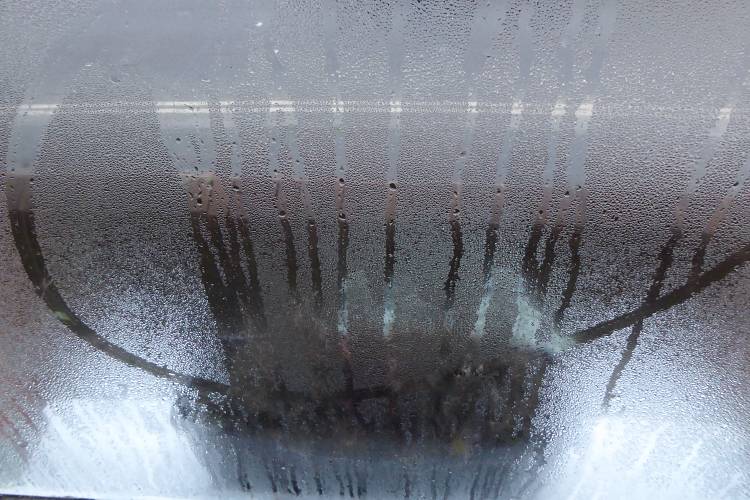
High Humidity/Cold surfaces
To first understand condensation related issues in your home, you MUST analyse the amount of moisture in the air. If you suffer with either mould or stagnant air, a hygrometer will give you factual data of the atmospheric conditions.
As a rule of thumb, we say that anything between 50% – 60% Relative Humidity (RH) is acceptable. Whereas RH levels over 70% is not acceptable and further investigation is needed to help reduce.
Cold surface temperatures will allow warm moisture laden air to condense upon it and turn to liquid water.
This water is not pure but tainted with bacteria, tiny creatures, and mould spores.
When this combination of water soaks into the walls, or wall papers, it soon takes life and colonises. This is when you start to see black mould appear and Thermal imagining cameras will be needed.


Don’t Just Wipe it…
Extract it.
The primary objective is to remove the excessive atmospheric moisture from the internal environment. Not simply wipe it away and hope it won’t come back.
You must look at the indicators and react to reverse the conditions that is giving life to the natural world. It is not good for anyone’s health to be surrounded by this amount of bacterial laden humidity.
Walls that are cold, unventilated, and constantly moistened by condensation will appear to have issues with rising or penetrating damp.
Therefore, it is crucial to test the air, investigate the surface temperatures and scrutinise all possible avenues with specialist equipment before reaching a diagnosis. You may also have to monitor the atmosphere.
Don’t rely on damp meters for this testing.


Improve your indoor air quality
If your property’s internal atmosphere – the very air you breathe – is loaded with mould spores, VOCs, bacteria, dust mites, pollen, and toxic carcinogens, it can have a serious impact on your life.
Black mould growth will thrive if the environment is damp enough. Initiate drying, ventilation and extraction and the problem will disappear and the air quality improved.
Heat Recovery Ventilation (HRV) virtually eliminates condensation and mould within a building by constantly ventilating that area. This means that that it eliminates the risk of cosmetic damage as well as mould, condensation, and musty cupboards.
Positive Input Ventilation or PIV Systems work by encouraging the movement of air from inside to outside from a unit that is installed in loft void. These PIV units reduce or eliminate surface condensation altogether by replacing humid stagnant air with fresh filtered air.

To Quickly Round Things Up:
- Condensation related problems are something to investigate and not to be ignored. If the atmosphere is high in humidity, you should actively work to reduce the levels so it cannot sustain life. Opening windows in the Winter just won’t cut it.
- Condensation related effects will tend to manifest itself as an ongoing damp issue, especially rising damp claims. The water is surface based and not underlying. A damp meter cannot tell the difference and will just scream WET and DAMP, without any logical scientific explanation.
- Try to produce less moisture. Keep lids on pans when cooking, only boil as much water as you need in the kettle, dry your clothes outdoors (and especially not on radiators) and make sure your tumble dryer has a vent to the outside.
- Warm months of the year, not cold, windows can be opened to remove humid air, or better use your extractor fan. Keep your bathroom door shut when taking a bath/shower to stop moisture escaping into the rest of the house and open a window to let it out instead.
- Let fresh air circulate. Make sure there’s a gap between your furniture and the walls, plus occasionally give wardrobes and cupboards a good airing.
- Heat cold rooms. These are more likely to get damp and mould than warmer rooms. Set the thermostatic radiator valve to 2 in unused rooms to give out a little bit of heat. Or if you don’t have central heating, maybe use a room heater with a timer and temperature control. Also, air rooms you don’t use very often.
- And if you are still in need of assistance and don’t want to waste your time and money, then we can help fix the situation – permanently!
- A simple hygrometer with 3 separate sensors can tell you a lot about your indoor environment.

